MSI Big Bang-XPower II X79 Review – A World of Novelty Heatsinks
by Ian Cutress on February 25, 2012 3:00 PM EST- Posted in
- Motherboards
- MSI
- X79
Test Setup
| Processor |
Intel Sandy Bridge-E i7-3960X 6 Cores, 12 Threads, 3.3 GHz (3.9 GHz Turbo) |
| Motherboards | MSI Big Bang-XPower II X79 |
| Cooling | Intel All-In-One Liquid Cooler, made by Asetek |
| Power Supply | Silverstone 1000W 80 PLUS Silver |
| Memory | G.Skill RipjawsZ DDR3-1866 9-10-9-28 1.5 V 4x4 GB Kit |
| Memory Settings | XMP |
| Video Cards |
XFX HD 5850 1GB ECS GTX 580 1536MB |
| Video Drivers |
Catalyst 11.8 NVIDIA Drivers 285.62 |
| Hard Drive | Micron RealSSD C300 256GB |
| Optical Drive | LG GH22NS50 |
| Case | Open Test Bed - CoolerMaster Lab V1.0 |
| Operating System | Windows 7 64-bit |
| SATA Testing | Micron RealSSD C300 256GB |
| USB 2/3 Testing | Patriot 64GB SuperSonic USB 3.0 |
Power Consumption
Power consumption was tested on the system as a whole with a wall meter connected to the power supply, while in a dual GPU configuration. This method allows us to compare the power management of the UEFI and the board to supply components with power under load, and includes typical PSU losses due to efficiency. These are the real world values that consumers may expect from a typical system (minus the monitor) using this motherboard.
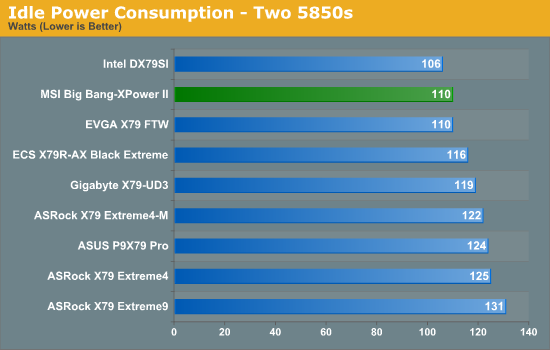
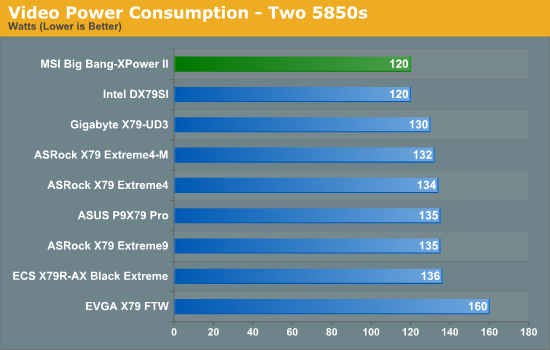

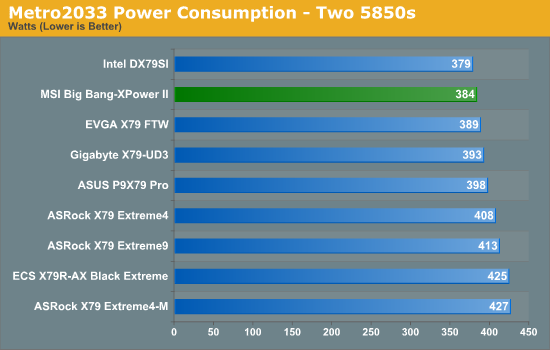
For an XL-ATX board, the MSI BBXP2 is spot on in its power consumption, being the most energy efficient (or the second most efficient) by default compared to other X79 boards tested.
CPU Temperatures
With most users’ running boards on purely default BIOS settings, we are running at default settings for the CPU temperature tests. This is, in our outward view, an indication of how well (or how adventurous) the vendor has their BIOS configured on automatic settings. With a certain number of vendors not making CPU voltage, turbo voltage or LLC options configurable to the end user, which would directly affect power consumption and CPU temperatures at various usage levels, we find the test appropriate for the majority of cases. This does conflict somewhat with some vendors' methodology of providing a list of 'suggested' settings for reviewers to use. But unless those settings being implemented automatically for the end user, all these settings do for us it attempt to skew the results, and thus provide an unbalanced 'out of the box' result list to the readers who will rely on those default settings to make a judgment. CPU Temperatures are not really indicative of quality or performance, even though one would postulate that worse parts may produce higher temperatures. However, if a manufacturer uses more conductive material in the power plane, this reduces resistance and increases the voltage at the CPU, causing a higher temperature but potentially better stability.
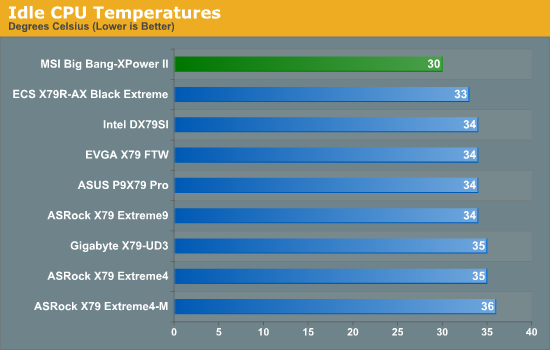
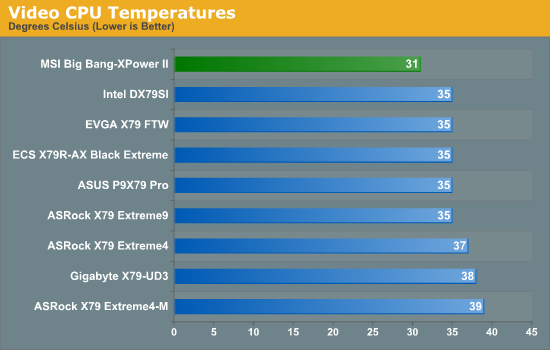
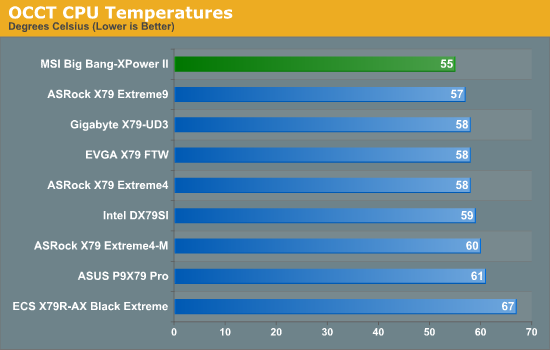
Impressively, the novelty heatsinks on the MSI seem to work wonders, producing our lowest ever CPU temperatures in idle, video and OCCT mode.










45 Comments
View All Comments
Sabresiberian - Sunday, February 26, 2012 - link
Are you kidding me?If you don't want to read a real review, I suggest you stop reading at Anandtech.com. There are plenty of sites that offer popcorn reviews for people like you.
Not everything can be said in a sound bite.
Keep up the good work, Ian!
;)
Iketh - Sunday, February 26, 2012 - link
What are you talking about? You're way off subject.mschira - Saturday, February 25, 2012 - link
So what is the maximum amount of working memory this supports?64 Gb? (8x8) or "only 32 (8x4)
Cheers
M.
earthrace57 - Saturday, February 25, 2012 - link
Most likely 64 GB unless they limited it somehow.I'm pretty sure its just how many GB or ram you can put in 1 stick at the time of making x number of slots...I don't think there really is a limitation.
Someone got 48 GB stable on a X58 motherboard, which is bound to 24 GB supposedly...
Zolcos - Saturday, February 25, 2012 - link
Odd that on such an expensive mobo with dual LAN and both kinds of spdif, they included firewire of all things but left out eSATA from the main cluster? It seems like a 'core' enough feature that it shouldn't require an expansion plate like this one does imo.bigboxes - Saturday, February 25, 2012 - link
This mobo has USB 3.0 so the need for eSATA will be minimal. However, if you still want it they provide a powered dual-eSATA bracket for the back. What more do you want?DanNeely - Sunday, February 26, 2012 - link
In addition because XL-ATX cases have room for 10 expansion slots you could mount the bracket between the main cluster and top GPU; so you it won't cut into your expansion like it would on a standard ATX system.iamkyle - Saturday, February 25, 2012 - link
Surprised the Marvell or Realtek mafia didn't come after MSI. FINALLY a reputable networking solution. Why can't every mainboard manufacturer do this?Iketh - Saturday, February 25, 2012 - link
Asus ROG motherboards have Intel also, along with X-Fi sound. The GENE-Z/GEN3 is only $180. I hope this is selling like hotcakes for them so it sends a message through the industry.Sabresiberian - Sunday, February 26, 2012 - link
The sound solution on Asus' otherwise excellent boards is really not significantly better than what other manufacturers offer without requiring a daughter card to take up the space of another slot.If you want more than what mainboards offer, then a discreet sound solution is still the only way to go. (I might suggest Asus' own products there.)
For my purposes onboard sound is a waste of money in the kind of build I want, I would rather there be no sound components at all built in the MB and the price be a little lower.
;)